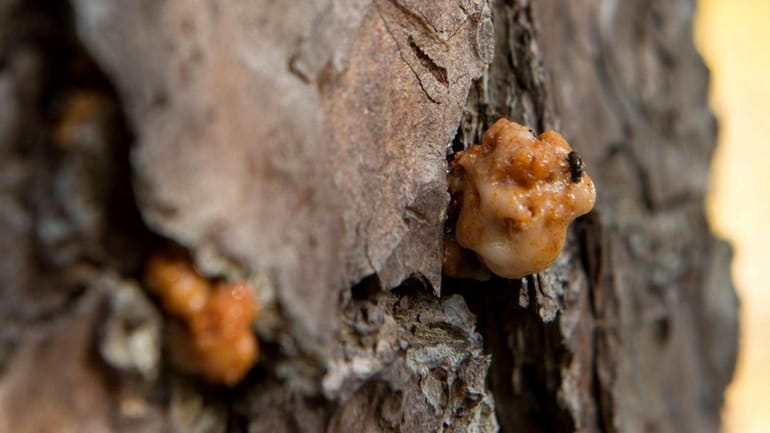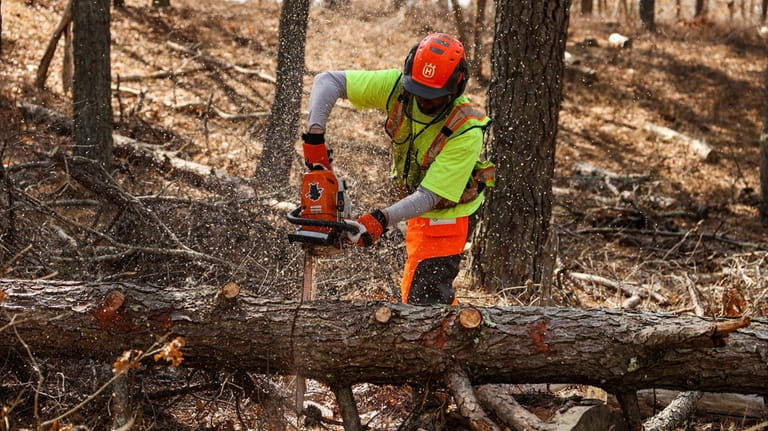Thousands of trees infected by southern pine beetles in Southaven, Manorville Hills to be cut down

Pitch tubes, or nodes of tree sap, which indicate the presence of the southern pine beetle, are visible on a pitch pine tree at the Wertheim National Wildlife Refuge in Shirley in 2014. The beetles, which burrow into the bark, can be seen as the small black specks on top of the sap. Credit: Daniel Brennan
Thousands of trees infected by the southern pine beetle will be cut down beginning next week in Southaven and Manorville Hills county parks, Suffolk and state Department of Environmental Conservation officials announced this week.
The plan, which calls for an estimated 2,000 to 5,000 trees to be taken down, is designed to slow the spread of the invasive species in the county's Pine Barren region. The southern pine beetle can kill trees in two to four months and quickly spread to other forestry, officials said.
“Every year, tens of thousands of individuals visit our parks for their natural beauty, but the Southern Pine Beetle poses a threat to our most treasured resources,” Suffolk County Executive Steve Bellone said in a statement released Wednesday. “We are working to proactively combat this environmental threat and by removing already infested trees, we will be able slow the spread and ensure a healthier ecosystem.”
While there's no way to completely eradicate the insect, the most effective strategy for minimizing its spread includes chopping down infected trees to create a buffer zone as the beetle typically spreads to pines that lie in proximity to the infected trees, county officials said.

Chris Steigerwald, a forest technician with the New York State Department of Environmental Conservation, cuts down a pine tree infested with southern pine beetles inside of the Rocky Point State Pine Barrens Preserve in April. Credit: Newsday/Steve Pfost
Once the trees have been felled, they'll be left in place and naturally decompose over time, replenishing the nutrient cycle within the ecosystem, officials said.
DEC Commissioner Basil Seggos said the state is working "proactively" with the county to address the pine beetle's threat to the region.
"In addition, DEC is managing other vulnerable forests using a combination of thinning and prescribed fire to increase forest health and resiliency, which helps prevent other forests from being attacked by [the southern pine beetle]," Seggos said.
The Central Pine Barrens Joint Planning and Policy Commission, which oversees conservation efforts and enforces development rules in the pine barrens — approximately 106,000 acres in parts of Brookhaven, Southampton and Riverhead towns — could not be reached Friday.
The southern pine beetle is native to the southeastern United States, but has been spreading up the Eastern Seaboard in recent years because of favorable climate conditions, state officials said.
The beetles, which are reddish brown to black in color and roughly the size of a grain of rice, kill pine trees by digging into the bark to lay eggs and interrupting the flow of nutrients. They first were found in Suffolk County in 2014 and do not attack hardwood trees.
The DEC will fund the cutting down of the trees, which begins on Tuesday, while the county will fund any management of the fallen trees, a Suffolk spokeswoman said. Dollar figures for the project were not available Friday.
The affected parks will remain open to the public, officials said, but there may be temporary closures of active work areas.
